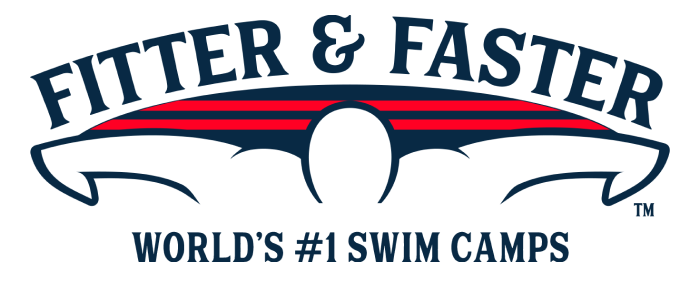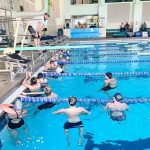Past Clinic: Racing At The Next Level Swim Camp (Grades 8th-12th)
Pike High School
5401 W 71st St,
Indianapolis,
IN 46268
A description of what was covered at this past clinic is below the upcoming clinics.
Upcoming Swim Clinics and Camps
Within 250 miles of Indianapolis, IN.
Past Clinic
Introduction
Just a few miles down the road from Lucas Oil Stadium - where the very best American Swimmers will be racing to earn a spot on USA's Swim Team to compete this summer in Paris - Fitter & Faster is producing a 9-day swim camp for competitive swimmers in Grades 8th - 12th!
The Racing at the Next Level Swim Camp will prepare competitive swimmers in grades 8th - 12th to swim faster, be more well-rounded athletes and give them an advantage in the college preparation process. Each day features a two-hours in-water session and one-hour in the classroom! Swimmers can sign up for individual days or all nine. Click here for the swim camp page for Grades 5th - 7th.
RACING AT THE NEXT LEVEL SWIM CAMP (Grades 8th - 12th)
-> DAY 1, June 15: Pool: Underwaters & Pullouts. Classroom: Nutrition & Hydration
-> DAY 2, June 16: Pool: Butterfly Technique. Classroom: Sleeping better for performance
-> DAY 3, June 17: Pool: Breaststroke Technique. Classroom: Mental Race Prep
-> DAY 4, June 18: Pool: Freestyle Technique. Classroom: USADA, Drug Testing & Banned Substances in Swimming
-> DAY 5, June 19: Pool: Backstroke Technique & Backstroke Starts: Classroom: Dynamic Warmup, Flexibility & Mobility
-> DAY 6, June 20: Pool: Explosive Block Starts: Classroom: College Recruiting - Finding Your Right Fit
-> DAY 7, June 21: Pool: Flip Turns. Classroom: Understanding College Financial Aid & Admissions
-> DAY 8, June 22: Pool: Open Turns & IM Exchanges. Classroom: Navigating the College Recruiting Process
-> DAY 9, June 23: Pool: Essentials of Sprinting & Pacing. Classroom: Bodyweight Dryland
Click the Curriculum Menu below for details on each day!
-> Session sizes are limited to ensure the best learning experience! SIGN UP before spots are filled!
-> Each day of this camp will be led by multiple Elite Fitter & Faster clinicians, executives and guest experts.
-> SAVE when you purchase a "Bundle" for this camp.
-> Leading this swim camp are Elite Clinicians and Coaches including Molly Hannis, Cierra Runge, Atiba Wade Mark Hesse, Mike Murray & Josh White!
FREE GEAR WITH YOUR PURCHASE!
-> Attend 1 to 3 sessions: Receive a free clear camp backpack
-> Attend 4 to 7 sessions: Receive a free clear camp backpack, camp t-shirt & camp silicone swim cap
-> Attend 8 or 9 sessions: Receive all of the above PLUS a Fitter & Faster Towel
* All gear will be given to the participant on the first day of the camp that they attend in Indy
** The clear backpack, t-shirt and silicone swim camp will all feature the special Fitter & Faster Indy 2024 Logo
Select a curriculum below
DAY 1, June 15: UNDERWATERS & PULLOUTS W/ NUTRITION AND HYDRATION
Top-level swimmers have faster times in “short course” pools than in “long course” pools because of the power they’re able to generate from the walls. Also, college swimming is in short course, so the walls are extra important for athletes who aspire to compete at the college level. We are going to work with each participant to improve the fastest sequence in every lap of every race race: streamline, underwater dolphin kick or pullout and breakout! The techniques covered in this session will help improve swimmers times in every race.
- STREAMLINE: The streamline - when done properly - is the fastest a swimmer travels while in the water. Proper streamlines are even faster than underwater dolphin kicking. Even the most elite swimmers in the world are constantly working on improving their streamline. Your swimmer will get tips to improve their streamline and a better appreciation of what they need to do on every single wall in practice and in races.
- INITIATING UNDERWATER DOLPHIN KICKING: College level and elite swimmers maximize their streamline on every single lap. So, they don’t want to start their underwater dolphin kicking while they’re still achieving maximum speed in their streamline. They also don’t want to start the underwater dolphin kicking after their streamline has begun to slow. Your swimmer is going to learn how to time when to begin their underwater dolphin kicking.
- POWERFUL UNDERWATER DOLPHIN KICKING: There are a few different techniques that swimmers use when underwater dolphin kicking. The common theme of these techniques is that the best swimmers kick up and down with equal power. We will show your swimmer the different techniques that elite swimmers use and teach them how to implement.
- NUMBER OF UNDERWATER DOLPHIN KICKS: Figuring out the optimal number of kicks off each wall, for each race, is essential to fast swimming. Elite swimmers want to spend only the absolute necessary amount of time underwater to establish speed with each length. They want to avoid losing their breath and taking weak kicks.
- BREASTSTROKE PULLOUTS: The best breaststrokers are faster under the water than on the surface! Swimmers will polish up the components and sequence of movements that make up a fast underwater breaststroke pullout.
- BREAKOUTS: Many swimmers add movement within their breakout that creates drag and destroys all of the speed created during their underwaters. Participants will work on timing their breakouts to explode into each lap.
- CLASSROOM CURRICULUM:
- NUTRITION & HYDRATION: Fueling and your body is crucial for elite performance. The key is knowing not just what to eat and drink, but also when. Learn situational nutrition and hydration strategies for times surrounding practice and competition.
- WHAT TO EAT: Improving your nutrition habits involves making healthier choices when it comes to food and drinks. Discover which foods and beverages can enhance your performance and learn how to make the optimal selections.
- TIMING: Understanding the timing of nutrition and hydration is crucial for optimizing performance. Explore strategies for fueling your body before, during, and after practice and competition to enhance your athletic performance.
- HOW MUCH TO EAT & DRINK: A swimmer's nutritional requirements vary depending on their training and competition level. Discover how to assess and adapt your food & drink intake to effectively fuel your body for success!
DAY 2, June 16: BUTTERFLY TECHNIQUE W/ SLEEPING FOR BETTER PERFORMANCE
At the highest level of swimming, butterfly is the second fastest stroke and beautiful to watch because of its rhythmic and powerful strokes. There are some complexities to establishing a smooth, rhythmic fly, but with practice and attention to detail your swimmer can master the stroke and begin swimming it for longer distances and at very fast speeds!
- BODYLINE: A butterfly race is going to be fastest with a proper bodyline. Even the slightest adjustment of the chin, neck, and/or back can make a huge difference. As swimmers mature in the sport and grow physically, their body position shifts and bad habits can emerge. Participants will learn and practice proper posture and engagement of their core to have a strong foundation for better technique - creating a full-body connection for more hydrodynamic and efficient butterfly strokes.
- KICK: Each butterfly stroke has two kicks to propel the swimmer towards the other end of the pool! If the kicks are properly timed and equally strong, they can positively impact your swimmer’s efficiency and stroke timing! Your swimmer will work on how and when to kick in butterfly for maximum speed.
- PULL: Long and smooth strokes allow swimmers to have a more efficient and fluid butterfly. The pull in butterfly keeps a swimmer accelerating forward. Your clinicians will work with participants to establish an early vertical forearm, “the catch”, enabling the swimmers to put immediate pressure back on the water. Properly completing the stroke keeps the swimmer moving forward efficiently and fast.
- BREATH: The timing of the breath in butterfly has a direct relationship on a swimmer’s body position, pull, kick and TIMES! At this camp, we will work with participants on breathing with their chin low to the water... and WHEN to breathe in their stroke cycle so that they develop the most efficient stroke possible!
- CLASSROOM CURRICULUM:
- SLEEPING FOR BETTER PERFORMANCE: Recovery is just as important as training hard. Enhancing your sleep can be a secret weapon for maximizing your performance during training and competition.
- SLEEP SCIENCE: Sleep is a vital component of both athletic and academic success. Discover the numerous benefits of getting proper rest and understand why prioritizing sleep is essential for optimal performance in sports and academics.
- SLEEP STRATEGIES: Discover effective strategies to prioritize sleep and enhance the quality of your rest.
- SLEEP & COMPETITION: Discover tips and techniques for maintaining healthy sleep habits while traveling, as well as the dos and don'ts of napping and competing to optimize your performance.
DAY 3, June 17: BREASTSTROKE TECHNIQUE W/ MENTAL RACE PREP
Out of the eight finalists at the Olympic Games, you might see eight different styles of breaststroke! A swimmer's timing and ability to eliminate resistance are hallmarks of an efficient and powerful breaststroker. No matter your swimmer’s level, this session will strengthen their technique and lead to faster and more efficient breaststroke races… and faster IM’s!
- BODYLINE: A breaststroke race is going to be fastest with a proper bodyline. Even the slightest adjustment of the chin, neck, and/or back can make a huge difference. Elite breaststrokers focus on minimizing drag by “catching water” on their hands and feet as quickly as possible, so they can shoot back into a “straight bodyline” where they can glide at top speed.
- KICK: The kick creates a lot of the power in breaststroke. Swimmers need to keep their knees high in the water and snap their feet quickly around and back to create a powerful kick. Our clinicians will work with participants to strengthen their kick for the ultimate propulsion forward!
- PULL: The name of the game in breaststroke is to create as much propulsion as possible in the pull while minimizing resistance… and then quickly getting back into a straight bodyline to establish a high speed glide. Participants at this session will focus on setting up a proper "catch" and keeping their hands and elbows high on the water throughout the entire pull. The techniques your swimmer will practice will minimize resistance and enable them to maintain forward momentum for the fastest breaststroke.
- TIMING: Fast, flowing breaststroke is the result of proper timing between a swimmer’s hands and feet. Establishing proper timing in your swimmer’s breaststroke will allow for more fluidity, power and speed. Participants in this session will learn how elite swimmers time their breaststroke for ultimate efficiency and the fastest races.
- CLASSROOM CURRICULUM:
- MENTAL RACE PREPARATION: It's common for even the most accomplished athletes to experience pre-race nerves. The key is to learn effective strategies for managing these nerves and preparing yourself to swim your best race. Discover proven techniques to eliminate distractions and optimize your performance in the water.
- WHY AM I NERVOUS?: Learn why even the most skilled athletes experience nerves before competitions and learn effective strategies to harness that energy and perform at your best.
- FOCUS: Boost your pre-race confidence by shifting your focus to things you can control. We will discuss effective strategies to eliminate distractions and optimize your performance in the water.
- ROUTINE: Developing a pre-race routine is essential for maximizing your performance and achieving success. Learn effective strategies and techniques to create a personalized routine that will help you prepare mentally and physically for your races.
DAY 4, June 18: FREESTYLE TECHNIQUE W/ USADA, DRUG TESTING & BANNED SUBSTANCES IN SWIMMING
Cultivating good habits to swim high level freestyle begins as soon as you learn the stroke. Even if your swimmer is already in high school - it’s never too late to begin practicing techniques that will drastically improve their efficiency, power and times. Today, your swimmer will work on techniques to strengthen their bodyline, catch, kick, pull, and breathing pattern.
- BODYLINE: A freestyle race is going to be fastest with the proper bodyline. Even the slightest adjustment of the chin, neck, and/or back can make a huge difference. As swimmers mature in the sport and grow physically, their body position shifts and often bad habits are created. Participants will learn and practice proper posture and engagement of their core to have a strong foundation for better technique - creating a full-body connection for more hydrodynamic and efficient strokes.
- ROTATION: Freestyle is fastest and most efficient when a swimmer’s body is “rotating” around their spine with each stroke. This part of swimming freestyle has a big effect on maintaining a proper bodyline. Participants will practice activating their core muscles to form a powerful connection from head to toe with every stroke.
- KICKING: A swimmer’s kick is the motor behind their freestyle! There are obviously proper and improper ways to kick which we will review at the camp. Just as important, however, is practicing the complexities of how and when swimmers need to “shift gears” in their legs to become stronger and faster racers.
- PULL: The pull in freestyle keeps a swimmer balanced and accelerating forward. This is a skill that needs cultivation throughout all swimmers’ careers. Having an early vertical forearm “catch” enables a swimmer to put immediate pressure back on the water. Properly completing the stroke keeps the swimmer moving forward efficiently. The later the “catch” or not “finishing” the stroke has a negative impact on a swimmer’s bodyline and speed.
- CLASSROOM CURRICULUM:
- USADA, DRUG TESTING & BANNED SUBSTANCES IN SWIMMING: Explore the rules and regulations surrounding the use of supplements and performance-enhancing substances to ensure fair competition and maintain integrity in sports.
- ANTI-DOPING & ATHLETES RESPONSIBILITIES: Athletes are held responsible for anything they put into and on their bodies. Learn how the US Anti-Doping Agency conducts drug-testing both in and out of competition to ensure a fair playing field.
- SUPPLEMENTS: Understand the rules and regulations of using supplements and performance-enhancing substances to compete fairly and maintain the integrity of your sport. Learn about the potential risks and benefits of using supplements and medications, and make informed decisions about what is safe and appropriate for your needs.
DAY 5, June 19: BACKSTROKE TECHNIQUE & STARTS W/ DYNAMIC WARMUP, FLEXIBILITY & MOBILITY
Developing strong habits for swimming at a high level in backstroke starts from the moment you begin learning the stroke. It doesn't matter if you're already in high school; it's never too late to start practicing techniques that will greatly enhance your efficiency, power, and race times. Today, we will focus on techniques to improve your bodyline, catch, kick, and pull, which will ultimately lead to faster backstroke races!
- BACKSTROKE STARTS: Your swimmer is going to learn and practice starting a high performance backstroke race. We’re going to work on a “clean”, fast water entry in which the athlete carries the momentum from the start into their streamline, underwater dolphin kicking and breakout.
- BODY LINE: A competitive swimmer’s bodyline is the key to fast swimming. The name of the game is to eliminate all extra movement of the body including even the slightest bobbing, wiggling. Participants will learn and practice proper posture and engagement of their core to have a strong foundation for better technique - creating a full-body connection for more hydrodynamic and efficient backstroke.
- ROTATION: Backstroke is fastest and most efficient when a swimmer’s body is “rotating” around their spine with each stroke. This part of swimming Backstroke has a big effect on maintaining a proper bodyline. Participants will practice activating their core muscles to form a powerful connection from head to toe with every stroke - resulting in faster backstroke!
- KICK: A swimmer’s kick is the motor behind their Backstroke! There are obviously proper and improper ways to kick which we will review at the camp. Just as important, however, is practicing the complexities of how and when swimmers need to “shift gears” in their legs to become stronger and faster racers.
- PULL: Just like in freestyle, the pull in backstroke keeps a swimmer balanced and accelerating forward. Essentially the best swimmers are creating a paddle with every stroke. The clinicians will work with participants to establish an early vertical forearm “the catch”, enabling the swimmer to put immediate pressure back on the water. Properly completing the stroke keeps the swimmer moving forward efficiently and fast.
- CLASSROOM CURRICULUM:
- DYNAMIC WARMUP, FLEXIBILITY & MOBILITY: In this classroom session, we will focus on dynamic warm-up exercises, flexibility training, and mobility exercises. These activities are designed to prepare your body for physical activity, improve your range of motion, and enhance your overall performance. Please bring athletic shoes, a t-shirt, and shorts.
- WHY "DYNAMIC" STRETCHING: Discover the benefits of incorporating active stretching into your warm-up routine to prepare your body for workouts & meets as well as improve your overall mobility. Gain a deeper understanding of the importance of warming up and learn effective techniques to enhance your performance.
- HOW & WHEN TO DO IT: We will focus on dynamic warm-up exercises, flexibility training, and mobility exercises to enhance your performance. Prepare for this class by bringing athletic shoes, a t-shirt, and shorts.
- PRE-HAB: Learn the importance of pre-habilitation exercises for the shoulders and groins to improve performance and reduce the risk of injuries. Discover effective techniques to strengthen these areas and enhance your athletic performance.
- SWIMMER SPECIFIC FLEXIBILITY: Improve your swimming performance by increasing your range of motion in key joints. Learn simple exercises that can be done daily to enhance flexibility in your ankles, knees, hips, and shoulders. These exercises can be easily incorporated into your routine, allowing you to maximize your efforts in the water.
- SWIMMER SPECIFIC MOBILITY: Mobility differs from flexibility in that it refers to the ease of moving throughout the range of motion. While there is overlap in some of the exercises that develop flexibility and mobility, it is also beneficial to focus on mobility at times. We will work with your swimmer on scapular and thoracic mobility.
DAY 6, June 20: BLOCK STARTS & RELAY EXCHANGES W/ COLLEGE RECRUITING - FINDING THE RIGHT FIT
The better a swimmer’s technique is off the starting block, the more speed they will carry into the water. Today, your swimmer improve their block start, relay exchanges & finishes!
- BLOCK STARTS: To ensure an explosive start, a swimmer needs to set themselves up properly on the block. The elite clinicians will work with participants on the optimal positioning of your swimmer’s entire body to allow for a quick reaction time and optimal speed.
- RELAY EXCHANGES: In relays, reaction time is crucial! At this camp your swimmer will learn skills that the best swimmers in the world use to time the “exchange” just right! If we react too quickly, we’ll start before the other swimmer finishes - and we’ll get disqualified. If we start too slow, we can lose our positioning in a race! Learning the proper technique for a well-timed start and an explosive relay dive will make your swimmer a valuable teammate.
- FINISHES: Races are won and lost by hundredths-of-a-second at every swim meet. Many races come down to the last few strokes. At this camp, your swimmer will learn techniques to set themselves up for a well-timed finish about 10 yards from the wall. A well-timed finish is also a valuable attribute for swimmers competing on relays so that the next person can time their start with precision.
- CLASSROOM CURRICULUM:
- COLLEGE RECRUITING - FINDING THE RIGHT FIT: Finding the right college swimming program is crucial for swimmers to have a fulfilling and successful collegiate experience. It's important to consider various factors such as the team's coaching staff, training facilities, academic support, and overall team culture. By carefully evaluating these aspects, swimmers can find a program that aligns with their goals and aspirations.
- COLLEGE LOGISTICS: When choosing a college swimming program, it's important to consider several factors to ensure the best fit for your swimmer. These factors include the competitive level of the program, the academic offerings and support, the location and cost of the college, and the potential position on the team. By taking these factors into account, swimmers can make an informed decision and find a program that meets their needs and goals.
- PRIORITIES: We will assist your swimmer in identifying their needs and preferences when it comes to choosing a college swimming program. By understanding their priorities, we can help them narrow down their search and find the program that best aligns with their goals and aspirations.
- TIMELINE: We will help your swimmer explore different college swimming programs and hone in on ones that might aligns with their goals and aspirations.
DAY 7, June 21: FASTER FLIP TURNS W/ COLLEGE FINANCIAL AID & ADMISSIONS
Quick, powerful turns and finishes are crucial to fast times and winning close races. The top age group, college and elite swimmers aren't using walls just for turning around - they are used to generate speed and momentum going into the next lap. College and Elite swimmers are constantly working their turns and looking for areas to improve them. Today, we're going to work with your swimmer on taking this crucial part of every race (and practice) to the next level!
- MOMENTUM: At the elite level of swimming, walls aren’t just used for turning around - they are used to generate speed and momentum going into the next lap. Outside of the elite ranks, many swimmers aren't gaining momentum and speed coming out of their turns! We will work with participants on the intricacies of approaching every wall at top speed and seamlessly initiating their “turn”.
- FLIP TURNS: Flip turns are an opportunity for your swimmers to increase momentum in the middle of a race! Flip turns in which the athletes slow down or have “mechanical” movements negatively impact the speed at which a swimmer comes off the wall. We will work with your swimmer to produce fast flip turns so that they can explode off the walls at maximum speed.
- STREAMLINE, UNDERWATER DOLPHIN KICKING, BREAKOUT PROGRESSION: At this session participants will continue to work on the progression covered on Day 1.
- CLASSROOM CURRICULUM:
- COLLEGE FINANCIAL AID & ADMISSIONS: Parents are encouraged to attend this class on the college admissions process. From A to Z, we will cover all the essential information you need to know to navigate the college application journey. Gain valuable insights, tips, and strategies to help your student succeed in the college admissions process.
- RULES: College swimming rules regarding financial aid and compensation, particularly in the NCAA, have rapidly changed over the last few years. You will learn what types of scholarships and other outside financial assistance, such as NIL, are permissible and which could count against team scholarship limits.
- FINANCIAL AID: In this classroom session, we will cover the college admissions process and provide valuable insights, tips, and strategies to help your student succeed.
- APPLICATION PROCESS: Learn what colleges are looking for and how to complete a rock solid application. Learn typical timelines for application and the differences between early decision (binding or not binding) and regular decisions. The relationship between admissions and athletics varies by school, we will help you with questions to ask coaches.
DAY 8, June 22: FAST OPEN TURNS & IM EXCHANGES W/ NAVIGATING THE RECRUITING PROCESS
Quick, powerful turns and finishes are crucial to fast times and winning close races. The top age group and elite swimmers aren't using walls just for turning around - they are used to generate speed and momentum going into the next lap. Elite swimmers are constantly working their turns and looking for areas to improve them. Today, we're going to work with your swimmer on taking this crucial part of every race (and practice) to the next level!
- MOMENTUM: At the elite level of swimming, walls aren’t just used for turning around - they are used to generate speed and momentum going into the next lap. Outside of the elite ranks, most swimmers stop or slow down while going into the wall, which kills their momentum! We will work with participants on the intricacies of approaching every wall at top speed and seamlessly initiating their “turn”.
- OPEN TURNS: Elite butterflyers and breaststrokers utilize speed from their last lap to create momentum and even more speed at the beginning of the next lap. Their open turns are actually not “turns”, but more like high-speed pivots. Participants in this session will work on these techniques to have much faster open turns!
- IM TRANSITIONS: The back-to-breast transition has a couple of ways that swimmers can approach it. Our Clinicians will work with participants to finesse their IM transitions and explore different types of transition turns so that they have the tools to go from the backstroke to the breaststroke leg the fastest way possible!
- STREAMLINE, UNDERWATER DOLPHIN KICKING, PULLOUTS & BREAKOUT PROGRESSION: At this session participants will continue to work on the progression covered on Day 1.
- CLASSROOM CURRICULUM:
- NAVIGATING THE COLLEGE RECRUITING PROCESS: This session will provide a step-by-step guide to the recruiting process for your swimmer. Parents are encouraged to attend and participate.
- THE PROCESS: We will provide a guide to the recruiting process, including NCAA, NAIA, and Jr. College recruiting rules and timelines. We will cover creating a recruiting profile, contacting coaches, attending camps and showcases, and making official visits. By the end of the session, you will have a clear understanding of the process and be equipped to help your swimmer navigate it successfully.
- CONTACTING COACHES: We will discuss the rules and guidelines for contacting NCAA coaches as a swimmer. You will learn when and how your swimmer should initiate contact with coaches to maximize their chances of recruitment.
- BEING INQUISITIVE: What are some key questions to ask college coaches during the recruiting process? How can you make the most out of your college visits? Gain insights into the most effective questions to ask and strategies to maximize your interactions with coaches.
- COLLEGE VISITS: How do I decide whether to visit a school? What are the differences between official and unofficial visits? Learn about the factors to consider when deciding whether to visit a school and the benefits of both official and unofficial visits.
- SCHOLARSHIPS: When should you inquire about scholarships and how do you determine if the financial aid offered is sufficient? Discover the best timing for discussing scholarships and learn strategies for evaluating financial aid packages.
- MAKING A DECISION: What is the timeline for deciding and committing to a college? How early do you need to make a decision and commit? Learn about the timeline for college decision-making and understand when it is necessary to commit to a college
DAY 9, June 23: ESSENTIALS OF SPRINTING & PACING W/ BODYWEIGHT DRYLAND TRAINING
Swimming fast requires good technique, efficiency, power, and a hard working athlete. Participants in this session will advance their skills that apply to fast swimming in every stroke. Now is the time for swimmers to establish and cultivate habits to swim their shorter races as fast as possible with good technique that will position them for success as they mature.
- BODY POSITION: A competitive swimmer’s body position is the key to fast swimming. Most swimmers are NOT hydrodynamic in the water - and that has a big effect on how fast they “allow” themselves to swim - especially as they get older. Let’s find the right body position for your swimmer.
- STROKE LENGTH: Lengthening their stroke will enable your swimmer to “catch” and hold onto more water to propel them as they swim. Whereas a short stroke is inefficient and not sustainable for very long. The clinicians will work with participants on this important skill for fast swimming.
- TEMPO: When sprinting short races young swimmers often tend to take too many strokes (“spin their wheels”) and not “hold onto the water”. At this camp we will find the appropriate tempo to maximize their own personal speed.
- BREAKOUTS: Many swimmers add movement within their breakout that creates drag and destroys all of the power created during their underwaters. Participants will work on timing their breakouts to accelerate to explode into each lap.
- WALLS!: Approaching the wall at top speed in preparation for the fastest turn is vital. Swimmers will work on techniques to get in and out of every wall faster!
- SPRINTING: Earlier in the session, your swimmer worked on body position, tempo and length of stroke. Now, we are going to apply those skills to swimming “all out” on top of the water with efficiency and power.
- PACING: “How should I swim this race?” How many times have you heard this? Swimmers of all ages and abilities have the same question. The technique for swimming a fast race changes depending on the distance. Learning to prioritize tempo and length of stroke, while maintaining efficiency has a huge impact on maximizing speed for sprints or increasing endurance for distance races. There are also many different ways to swim a fast race! The name of the game is understanding all the different ways to execute the race and seeing what works for you!
- SPRINTING & PACING APPLICATION: Swimmers at this session will work on applying their newly developed skills during racing scenarios. As with all the other segments of this camp, the clinicians will provide feedback for your swimmer to take home and apply at upcoming practices and meets.
- CLASSROOM CURRICULUM:
- BODYWEIGHT STRENGTH TRAINING: While your swimmers club likely has a dryland program focused on the larger physical training, you don’t always need access to a weight room or other equipment. We will introduce some dryland that they can do on their own both in- and out-of-season that can have a dramatic impact on their performance. Please bring athletic shoes, a t-shirt and shorts for this class.
- BODYWEIGHT STRENGTH TRAINING: Discover and engage in key exercises that promote overall strength and enhance your speed in the pool. Gain knowledge and practice key exercises that will help you maintain your well-being and improve your performance in the water.
- PLYOMETRIC TRAINING: Jumping, bounding and skipping are great ways to improve strength and explosiveness and have a direct correlation to start and push-off velocity. Learn key exercises you can do almost anywhere.
SESSION START TIME FOR EACH DAY:
- Check in: 12:45 PM
- Water Session: 1:15-3:15 PM
- Classroom Session: 3:30-4:30 PM
ASK QUESTIONS
Swimmers and parents are invited to ask the clinicians questions during a Q&A session. Gain insight into their training regimen, diet and nutrition, and recovery tactics.
WATCH THE CLINICIANS
Observe clinicians swim at full speed and demonstrate a progression of perfectly executed drills to achieve powerful, efficient and fast swimming.
PUT YOUR SKILLS TO THE TEST
Swimmers will get to practice what they've learned by taking their stroke to your top speed with some of the best swimmers and coaches in the world! They'll work on holding onto their form while challenging themselves.
Take a photo, get autographs, and chat with your clinicians! All participants will also receive a special Gift Bag courtesy of our Sponsors!

Atiba Wade
Atiba Wade is a strength and conditioning coach who creates programs designed for swimmer specific and athletically focused exercises that meet the demands of a competitive aquatic environment. Atiba was also a 2x Olympic Trials Qualifier and a University of Georgia All American Swimmer! Sign up for a clinic with Atiba and improve your fitness and swimming technique while challenging yourself and having fun!
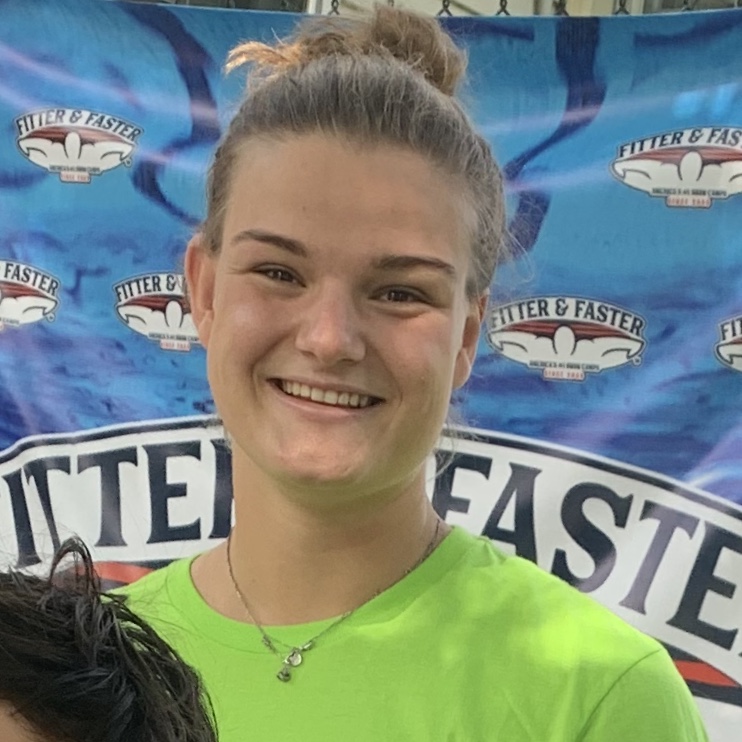
Cierra Runge
Cierra Runge is known for her Olympic gold medal, her knowledge of freestyle technique, her incredible work ethic, and her infectious smile! Cierra has an incredibly fun and outgoing personality that makes her a very effective teacher! Sign up to work with and learn from a champion both in and out of the pool.
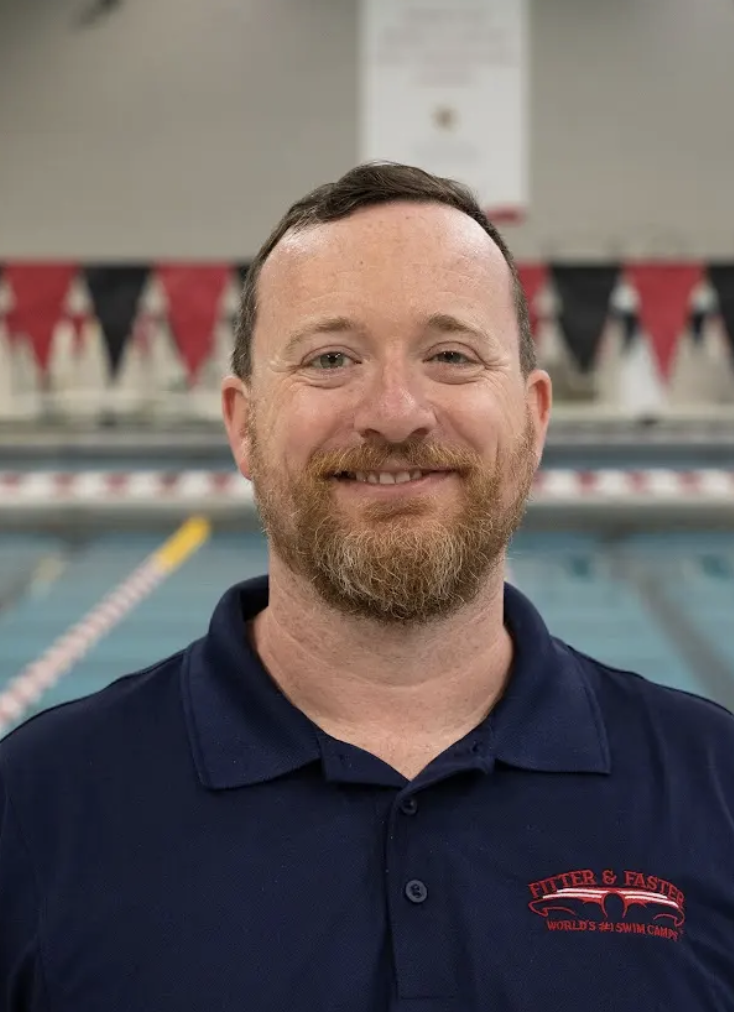
Josh White
Dr. Josh White, with over 20 years of coaching experience—including 15 as Associate Head Coach at the University of Michigan—brings both expertise and passion to his clinics. He coached at the 2012 Olympics for Barbados, served on USA Swimming’s international staffs, and led athletes to seven U.S. Open and American records. With a Ph.D. in Human Performance from Indiana University’s Counsilman Center for the Science of Swimming, Dr. White blends deep scientific knowledge with engaging, technique-driven coaching that connects swimmers to the “why” behind each skill. He also oversees curriculum development and our Zoom Education Series, continuously enhancing our educational reach.

Mark Hesse
Coach Mark Hesse is Fitter & Faster's Director of Education and Swimming Performance! Mark is widely known for proactively working with coaches and swimmers at each progressive level: from the beginner swimmer to the Olympian. He studies and teaches trends in stroke technique, training, nutrition, seasonal planning, use of video and race stats, goal setting, psychology and much more! He is a master of developing healthy, highly successful athletes and teams with an emphasis on coach mentorship, relationship building, team dynamics and communications.

Mike Murray
Murray will not only inspire swimmers but also coaches and parents attending his clinics. He is able to give knowledgeable feedback regarding training and racing strategy at all levels. With decades of swimming, coaching and speaking experience, he will share his wealth of knowledge with every participant in attendance at his clinics.
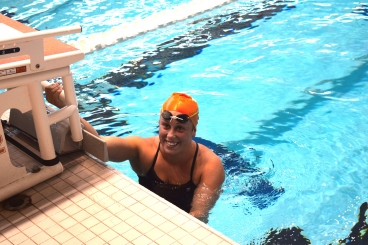
Molly Hannis
Molly Hannis has made her mark on swimming after becoming an NCAA champion as well as an Olympian in breaststroke. She continuously is known for finding unique and brilliant ways to think outside of the box to swim faster. Molly is a wealth of knowledge that all swimmers will benefit from.

Elite Clinician
Fitter and Faster clinicians are Olympians and National Team members who have achieved at the highest level of the sport of swimming... and who have the unique skill to teach what they know from a technical perspective to swimmers of all ages and abilities.
Inquisitive, Educated Swimmers are Faster Swimmers! Sign up today!
Search all of our clinics...or request a clinic in your area



